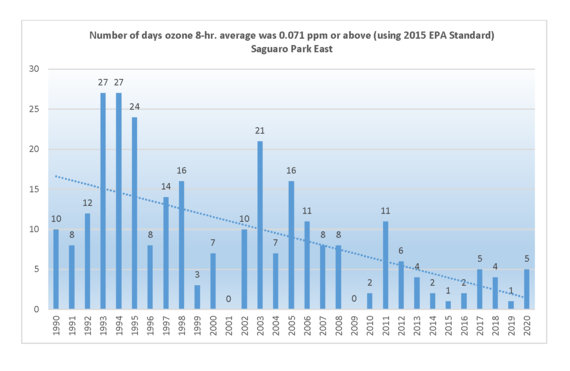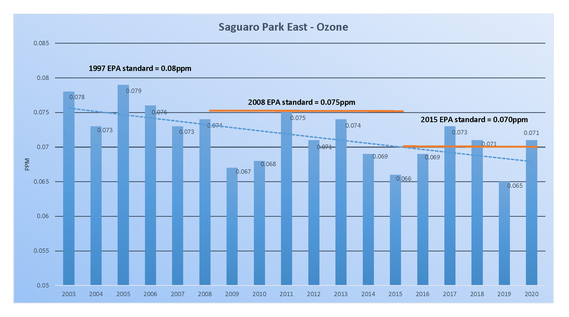Pima County, April 29, 2021 – As days grow longer and hotter in southern Arizona, levels of the air pollutant ground-level ozone begin to climb. Ozone pollution season begins in April and lasts through September. Fortunately, the air quality in Pima County is usually in the “good” or “moderate” range during this time period. There are days, though, when the air we breathe can be unhealthy, especially for those who are sensitive to ozone. Inflamed airways, difficulty breathing, coughing and increases in asthma attacks are some of the health effects that can occur by breathing elevated levels of ozone air pollution.
The U.S. Environmental Protection Agency (EPA) reviews health studies periodically as well as alters the health standard as appropriate to be protective of public health. In 2020, the air in Pima County exceeded the most current U.S. EPA ozone standard established in 2015 on eight days as measured by Pima County Department of Environmental Quality (PDEQ) air quality monitors. The 2019 ozone season had only one day exceeding the standard.
Ozone as a Pollutant
“Ozone is a very complex air pollutant. It is created during a photochemical reaction with two other pollutants when weather conditions are favorable,” said Ursula Nelson. Nelson is the PDEQ Director. “Ozone needs intense sunlight, still air and the right ratio of volatile organic compounds and nitrogen oxides,” Nelson said.
Ground-level ozone is different than the protective ozone layer in the stratosphere that shields us from solar radiation. Ground-level ozone is at nose and lung level. It comes from different sources. This pollutant tends to be elevated in the spring and summer months. This is when our region has more hours of intense sunlight to react with the ozone precursor emissions. In addition, warmer temperatures increase the amount of volatile organic compound (VOC) emissions. These evaporate from gasoline, solvents, paints, and even vegetation. VOCs are one of the key ingredients in the formation of ozone, along with nitrogen oxides. These come primarily from the burning of fossil fuels such as in motor vehicles.
It is also important that ozone levels stay below the 0.070ppm health standard set by the U.S. EPA, not only to protect public health but also to protect the local economy. If the County is designated as “non-attainment” for this pollutant in the future, it may deter businesses from expanding or moving to the area due to potential development restrictions.
There are many actions we can take as individuals to reduce emissions that contribute to ozone. Incorporating these actions, even occasionally, will help protect the physical and economic health of individuals and the community.
What can we do to reduce ozone emissions?
- Maintain our vehicles
- Refuel in the evening
- Share rides
- Replace car trips with biking, walking or taking transit
- Drive and idle our vehicles less
- Work from home
- Reduce the use of gas powered lawn and garden equipment

As depicted in the graph to the right by the Arizona Department of Environmental Quality (ADEQ), ozone is typically highest in the afternoon from around 12:00 p.m. until around 6:00 p.m. Real-time ozone air pollution levels are available on the PDEQ website and individuals can sign up with ADEQ to receive air pollution forecasts in order to plan ahead, reduce exposure, and drive less on forecasted high ozone days. Additional information on ground-level ozone is available on the PDEQ website and graphs of historic ozone information are included below. The first graph shows the number of exceedance days if the current ozone standard had been in place going back to 1990 and indicates that, in general, there has been a decline in those unhealthy days. The monitoring site at Saguaro Park East tends to have the highest ozone readings.

The graph below shows the strengthened through time EPA health standard for ground-level ozone in addition to pollutant concentrations over time at Saguaro Park East.

Contact:
Karen Wilhelmsen, 520-724-7449, karen.wilhelmsen@pima.gov
Finally, check out our blog for more news.
